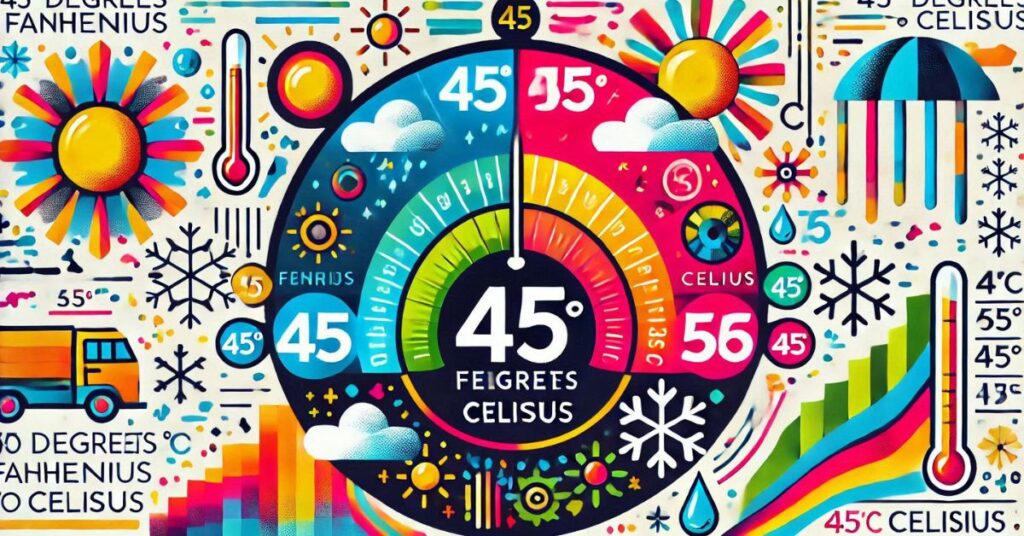45fahrenheit to Celsius and Fahrenheit temperature scales are essential to day-to-day living, impacting everything from weather forecasting to cookery. Understanding how to convert temperatures between different scales is crucial, particularly for scientific study, international travel, and comprehending weather reports from around the world. With the correct formula and equipment, converting 45°F to Celsius is a typical conversion that is simple. Let’s examine this conversion’s background, computation, and importance.
Understanding the Fahrenheit and Celsius Scales
45fahrenheit to Celsius Gabriel Fahrenheit created the Fahrenheit scale in the 18th century, and it is still commonly used in the US today for routine tasks like setting domestic temperatures and predicting the weather. Its defining points are the freezing point of water (32°F) and its boiling point (212°F), which form a special 180-degree range.The Celsius scale, on the other hand, was created by Anders Celsius and is now used worldwide for meteorological, medical, and scientific purposes. For the majority of users, it provides a more straightforward and understandable scale by setting the freezing and boiling points of water at 0°C and 100°C, respectively. The Celsius scale is the accepted norm globally as its metric foundation is in line with the International System of Units (SI).
The Importance of Converting Fahrenheit to Celsius
Temperature conversions are crucial for interpreting data across different fields. For example:
- Weather Reports: Many international travelers need to convert Fahrenheit to Celsius to understand local weather conditions.
- Scientific Research: Laboratories and research facilities primarily use the Celsius scale for precision and consistency.
- Cooking Instructions: Recipes often specify oven temperatures in either Fahrenheit or Celsius, depending on their country of origin.
Accurate temperature conversions bridge the gap between these scales, enhancing communication and understanding in various scenarios.
How to Convert 45 Fahrenheit to Celsius
The formula for converting Fahrenheit to Celsius is simple:
°C=(°F−32)×59\text{°C} = (\text{°F} – 32) \times \frac{5}{9}°C=(°F−32)×95
Let’s break this down for 45°F:
Subtract 32: Start by subtracting 32 from the Fahrenheit temperature.
45−32=1345 – 32 = 1345−32=13
Multiply by 5/9: Multiply the result by the fraction 59\frac{5}{9}95.
13×59=7.2213 \times \frac{5}{9} = 7.2213×95=7.22
Thus, 45°F is approximately 7.22°C.
This straightforward calculation makes it easy to interpret temperatures in Celsius, whether for understanding weather patterns or cooking precise recipes.
Practical Applications of Temperature Conversion
Converting temperatures between Fahrenheit and Celsius has practical significance in various domains:
1. Weather Forecasts
The majority of other nations use Celsius for weather reporting, however the United States uses Fahrenheit. Accurate prediction interpretation, which might affect outdoor activities, wardrobe choices, and travel arrangements, is ensured by knowing how to convert between these scales.
2. Cooking and Baking
Numerous recipes include oven temperatures in Fahrenheit, particularly those found in American cookbooks. Converting a recipe that specifies 45°F as the minimum temperature setting to 7.22°C, for example, guarantees consistency, particularly when utilising metric ovens.
3. Scientific and Industrial Use
Celsius is the standard scale for accuracy in research and manufacturing. Accurate conversions are essential for industrial operations, whether they involve monitoring chemical reactions or establishing temperatures.
Tools for Temperature Conversion
In the modern age, various tools simplify the process of converting Fahrenheit to Celsius:
- Online Calculators: Websites offer instant conversions for user convenience.
- Mobile Apps: Many apps provide not only temperature conversion but also additional features such as unit conversions for distance, weight, and volume.
- Manual Charts: Printed conversion tables serve as a quick reference, especially in classrooms or laboratories.
These tools cater to diverse preferences, ensuring that anyone can convert temperatures quickly and accurately.
Household appliances such as ovens and thermostats.
Celsius in Science and Medicine
Globally, Celsius dominates in fields like:
- Healthcare: Measuring body temperature in Celsius ensures uniformity in medical records.
- Meteorology: Global weather organizations use Celsius to report climate data.
By understanding both scales, individuals can seamlessly adapt to different settings and requirements.
Tips for Accurate Temperature Conversion
To ensure accuracy when converting Fahrenheit to Celsius:
Always double-check calculations.
Use a reliable calculator or conversion app.
Familiarize yourself with key reference points, such as 32°F (0°C) and 212°F (100°C).
These practices minimize errors and enhance confidence in interpreting temperatures.
Also Read: https://everscroll.org/hilltop-auto-gordon/
Conclusion
Converting 45°F to Celsius, resulting in approximately 7.22°C, highlights the interplay between the Fahrenheit and Celsius scales. Understanding these conversions is vital for interpreting weather reports, following recipes, and engaging in scientific research. With tools like online calculators and mobile apps, temperature conversions have never been easier.
Knowledge of both scales guarantees accuracy in both personal and professional contexts and improves communication across borders. Understanding temperature conversion helps you bridge the gap between these two crucial systems, whether you’re cooking, travelling, or analysing data.
FAQs About (45fahrenheit to Celsius)
1. Why is 45°F equivalent to 7.22°C?
This conversion is based on the formula °C=(°F−32)×59\text{°C} = (\text{°F} – 32) \times \frac{5}{9}°C=(°F−32)×95. Subtracting 32 from 45 and multiplying by 5/9 yields approximately 7.22°C.
2. Is Celsius more accurate than Fahrenheit?
Both scales are accurate but serve different purposes. Celsius is metric-based and widely used in science, while Fahrenheit offers finer gradations for everyday use in the U.S.
3. Can I use a smartphone app for temperature conversion?
Yes, many apps provide instant and accurate temperature conversions, catering to various user needs.
4. What are some key temperature milestones in both scales?
Freezing point of water: 32°F (0°C)
Boiling point of water: 212°F (100°C)
Average human body temperature: 98.6°F (37°C)
5. How can I remember the conversion formula?
A helpful mnemonic is “Subtract 32, then multiply by five-ninths.” Repeating this formula regularly reinforces memory.

